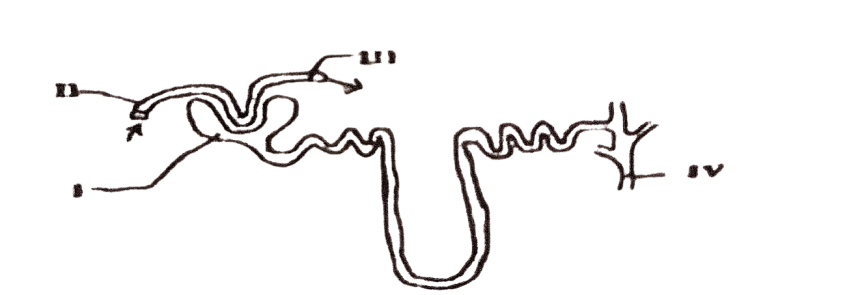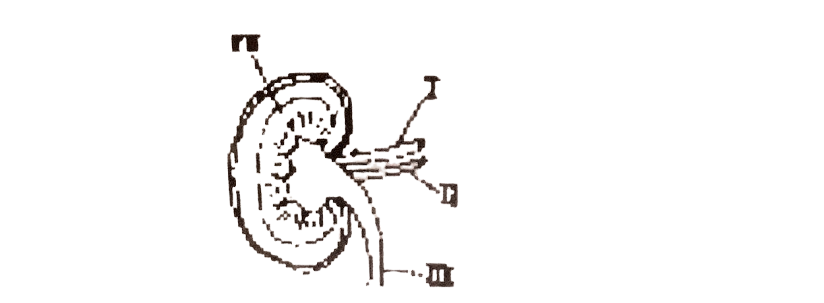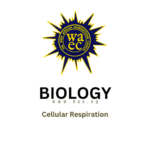OBJECTIVES
1. The diagram below is an illustration of the human excretory system which of the labelled parts contains
the highest amount of nitrogenous waste?

A. I.
B. II.
C. IV.
D. VI.
2. A substance present in the glomerular filtrate in the mammalian kidney is
A. glucose.
B. fibrinogen.
C. albumen.
D. blood platelets.
3. In humans, excretion of hypertonic urine is associated with the
A. distal convoluted tubule.
B. loop of Henle.
C. bowman’s capsule
D. proximal convoluted tubule.
4. Which part of the nephron is associated with ultra- filtration?
A. Distal convoluted tubule.
B. Proximal convoluted tubule.
C. Collecting duct.
D. Bowman’s capsule.
5. Which of the following organisms have kidney as their excretory organ?
A. Fishes, amphibians, birds, man.
B. Fishes, amphibians, annelids, insects.
C. Fishes, reptiles, birds, tapeworms.
D. Fishes, protozoans, amphibians, man.
6. Which of the following substances is not usually present in the urine of a healthy person?
A. Urea.
B. Mineral salts.
C. Glucose.
D. Water
7. The Malpighian body of the mammalian kidney is made up of
A. cortex and medulla.
B. Bowman’s capsule and loop of Henle.
C. glomerulus and Bowman’s capsule.
D. pelvis and pyramid.
8. Filtrate in the Bowman’s capsule contains vitamins because
A. only a little amount is required by the body.
B. they can be reabsorbed into the blood.
C. they have low molecular weight
D. most of them are fat soluble.
9. Ultrafiltration in the kidney takes place in the
A. renal vein.
B. medulla.
C. loop of Henle.
D. Bowman’s capsule.
10. The excretory system in mammals consists of the following parts except
A. two kidneys.
B. two ureters.
C. two bladders:
D. one urethra.
The diagram below is an illustration of the urinary tubule in a mammal. Study it and answer questions 11 to 13

11. Which of the following substances is found in the part labelled II only
A. Lipid.
B. Protein.
C. Salts.
D. Water.
12. The part which contains the lowest concentration of urea is labeled
A. 1.
B. II.
C. III.
D. IV.
13. Which of the following substances is greater in concentration in the part labelled IV when compared to that of the part labelled I?
A. Lipid.
B. Glucose.
C. Urea.
D. Uric acid.
14. The organelle which eliminates water from the body of a protozoan is the
A. plasma membrane.
B. contractile vacuole.
C. nucleus.
D. cell wall.
15. The following characteristics are associated with the mammalian lungs except
A. large surface area.
B. expandable lungs.
C. moist surface.
D. highly vascularized.
16. The excretory product in protozoans is
A. amino acid.
B. uric acid.
C. ammonia.
D. urea.
17. Which of the following substances is not an excretory product of animals
A. Carbon dioxide.
B. Urea.
C. Sweat.
D. Oxygen.
18. Excretion in Paramecium sp. is by diffusion because
A. its habitat is water and moist places.
B. it has simple, small and few internal organs.
C. it has a large surface area to volume ratio.
D. it has a large efficient meganucleus.
19. Which of the following structures functions as an excretory system found in flatworm?
A. Contractile vacuole.
B. Nephridium.
C. Flame cell.
D. Malpighian tubule.
20. Which of the following organs is associated with deamination of proteins?
A. Lung.
B. Stomach.
C. Kidney.
D. Liver.
21. Ultrafiltration in the kidney takes place in the
A. loop of Henle.
B. renal vein.
C. Bowman’s capsule.
D. pelvis.
22. Which of the following definitions best describes excretion?
A. liberation of energy from food.
B. release of faeces from the body.
C. breakdown of food molecules.
D. removal of the waste products of metabolism.
23. In which of the following organisms is ammonia excreted as a waste product?
A. Man.
B. Bird.
C. Amoeba.
D. Spirogyra.
24. Which of the following are components of glomerular filtrate?
A. All the components of blood except mineral salts.
B. Water and salt only.
C. All the components of blood except plasma protein and cells.
D. Plasma proteins, red and white blood cells.
25. The mechanism by which useful materials in the glomerular filtrate are taken back into the blood is
known as
A. filtration.
B. reabsorption
C. haemolysis.
D. osmosis.
26. Which of the following takes place during the process of detoxication in the liver?
A. Poisonous substances in the body are converted into harmless substances.
B. Fats and oils are broken into finer particles through emulsification.
C. Excess glucose in the blood are converted into glycogen and stored.
D. Worn-out red blood cells are broken down.
27. The cup-shaped part of the Bowman’s capsule contains the
A. nephridium.
B. glomerulus.
C. loop of Henle.
D. nephron.
28. Which of the following organs in humans is responsible for the removal of excess water?
A. The spleen.
B. The kidney.
C. Large intestine.
D. Small intestine.
29. Deamination is the process during which
A. excess amino acid is broken down into ammonia and a keto-acid.
B. fats and oils are converted into an emulsion for to absorption.
C. excess glucose is converted and stored as glycogen in the liver.
D. glycogen is reconverted into glucose through the action of glucagon.
30. Which of the following statements on urine production is not correct?
A. Concentrated urine is produced under the control of antidiuretic hormone.
B. The total volume of urine produced depends on the need for water excretion.
C. if there is an excess intake of water, dilute urine is excreted.
D. if there is a shortage of water in the body the volume of urine produced decreases.
31. Kidney stone is a disease of the kidney that results in the
A. blockage of the tubules by solid particles.
B. passing out useful materials of the body fluid with urine.
C. presence of large quantity of water in urine.
D. passing out hormones in urine.
32. The following are the activities of the liver except
A. production of heat.
B. manufacture of bile.
C. detoxication of alcohol and drugs
D. Maintenance of osmotic balance
33. The malpighian tubule plays a major role in
A. inspiration.
B. digestion.
C. secretion.
D. excretion.
34. When a person’s urine contains a high concentration of urea, it could be the result of
A. a drop in body temperature.
B. having diabetes melitus.
C. eating a meal rich in protein.
D. drinking a large amount of water.
35. Which of the following organs in mammals is not excretory in function
A. Liver.
B. Kidney.
C. Pancreas.
D. Lungs.
36. Which of the following substances is not an excretory product in mammals
A. Carbon dioxide.
B. Water.
C. Faeces.
D. Urea.
37. Which of these is not an excretory product of plant?
A. Tannin.
B. Gum.
C. Alkaloid.
D. Sweat.
38. Which of these is not a function of the kidney?
A. Production of urine.
B. Maintenance of acid-base balance in the body.
C. Osmoregulation.
D. Production of bile.
39. In which part of the kidney does ultrafiltration
take place?
A. Bowman’s capsule.
B. Distal convoluted tubule.
C. Proximal convoluted tubule.
D. Collecting duct.
40. Which of the following organs is concerned with detoxication of harmful compounds?
A. Kidney.
B. Lungs.
C. Gall bladder.
D. Liver.
41. The process whereby poisonous compounds are made harmless in the liver is called
A. deamination.
B. glycolysis.
C. dehydration.
D. detoxification.
42. Which of the following is an excretory product of Amoeba?
A. Urea.
B. Ammonia.
C. Uric acid.
D. Amino acid.
43. Which of the following is the correct route for the movement of materials through the kidney?
A. Glomerulus Bowman’s capsule Loop of Henle Collecting tubule Pelvis.
B. Glomerulus Loop of Henle Collecting tubule Bowman’s capsule Pelvis.
C. Pelvis Bowman’s capsule Glomerulus Loop of Henle Collecting tubule.
D. Bowman’s capsule Glomerulus Loop of Henle Collecting tubule Pelvis.
44. Which of the following parts of the mammalian skin is directly involved in excretion?
A. Sebaceous gland.
B. Sweat gland.
C. Hormy layer.
D. Hair follicle.
45. Which of the following substances is a common excretory product in both plants and animals?
A. Urine.
B. Oxygen.
C. Mineral salts.
D. Carbon dioxide.
46. The glomerular filtrate contains the following substances except
A. water.
B. urea.
C. blood corpuscles.
D. glucose.
47. Reabsorption of the metabolic products along the kidney tubules is made possible by the
A. closeness of the intestine to the kidney.
B. convoluted nature of the tubules.
C. presence of convoluted tubules in the medulla.
D. presence of network of capillaries around the convoluted tubules.
48. Ultra-filtration process at the Bowman’s capsule is facilitated by
A. the volume of water in the blood.
B. the high concentration of urea in the blood of the Bowman’s capsule.
C. the differential blood pressure between the glomerulus and bowman’s capsule.
D. the differential blood volume between the glomerulus and the Bowman’s capsule.
49. Glomerular filtrate contains
A. no glucose.
B. amino
C. detoxication of alcohol and drugs.
D. maintenance of acids.
50. Which of the following is not a function of the liver in mammals?
A. Storage of some vitamins.
B. Conversion of glycogen into glucose.
C. Deamination of excess nitrogenous substances.
D. Filtration of urea from the blood.
51. Which of the following performs the same function as the contractile vacuole of a unicellular organism?
A. Kidney.
B. Alimentary canal.
C. Liver.
D. Pancreas.
52. In which of the following groups is nephridium found?
A. Crustaceans.
B. Reptiles.
C. Birds.
D. Annelids.
53. The excretory product of some reptiles, birds and insects is
A. Urea.
B. Urine.
C. Ammonia.
D. Uric acid.
54. The part of the mammalian kidney that stores urine is the
A. Capsule.
B. Medulla.
C. Pelvis.
D. Bladder.
The diagram below is an illustration of the longitudinal section of a mammalian organ. Study it and answer questions 55 and 56.

55. Which of the labelled parts is the cortex?
A. I
B. II
C. III
D. IV
56. What is the main function of the organ?
A. Excretion.
B. Respiration.
C. Reproduction.
D. Locomotion.
57. Detoxification of urea takes place in the
A. pancreas.
B. heart.
C. liver.
D. testes.
THEORY
1. (a) What is excretion? (b) Name the excretory organs in: (i) insect (ii) earthworm. (c) How does the mammalian kidney function as an excretory organ? (d) List the excretory organs in humans and name one waste product excreted by each organ
2. Define the following terms: (a) elimination (b) excretion (c) secretion
3. State four functions which the liver of a patient suffering from cancer of the liver will not be able to perform
4. (a) List two diseases of the liver (b) State five effects of the diseases on the human body. [2011/2]
5. Copy and complete the table below
| Diseases | One effect | One remedy |
| Kidney stones | ||
| Nephritis | ||
| Diuresis |
6. In a tabular form, state three differences between excretion in flowering plants and excretion in humans
7. (a) List three functions of the kidney (b) Make a labelled diagram of the mammalian kidney tubule (nephron) (c) Describe how the kidney carries out two of the functions listed in a above
8. (a)(i) List five excretory organs found in living organisms (ii) Give one example of an organism in which each type is found (b)(i) State two ways in which the excretory organ of earthworm is similar to that of mammals (ii) Give three differences between them
9. Name the excretory organ in (i) insects (ii) earthworm.
10. Complete the table below.
| Organ associated with excretion in humans | Three diseases each that affect the organ | |
| (i) | ||
| (ii) |



